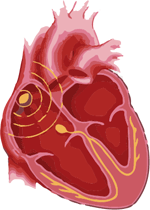Bradycardia symptoms
Bradycardia is a heart arrhythmia that is characterized by a very slow heartbeat, generally lower than 60 beats a minute. This leads to complications and heart can not pump enough oxygen-rich blood into the body. Bradycardia symptoms are not the same for all persons with this heart disease, for some people bradycardia does not cause problems, neither symptoms appear, generally people who are physically fit, for example, sportsmen who regularly train, at rest have a very slow heartbeat.
Bradycardia symptoms are fatigue, weakness, shortness of breath, fainting, dizziness, memory problems and sleep problems.
The most common bradycardia symptom is fatigue, which occurs because of slow heart rate and occurs even during the resting. In some people it can cause a lack of strength to perform daily activities.
Symptom, which also belongs to the bradycardia is fainting which causes temporary loss of consciousness. Fainting is one of the most dangerous symptoms of bradycardia, some people totally lose consciousness and some are on the verge of losing consciousness, and it is a very alarming situation. In this situation, most likely, it is necessary to install a pacemaker, to control the heart rate.
In some people with bradycardia occurs the symptom shortness of breath accompanied by chest pain or dizziness, which can lead to loss of consciousness. Dizziness and head pain can occur at any time.
The problem with sleeping belongs to the bradycardia symptoms that can occur during some nights. This symptom may occur for some people but not for others as well as the other mentioned symptoms. In patients with slow heart rate additionally may occur and memory impairment, causing difficulty in remembering, that can lead to confusion. If bradycardia does not manifest symptoms, then you do not need treatment. Severe bradycardia may lead to emergency situation due to lack of oxygen to the brain, and death can occur unless patient take the necessary treatments to raise the heart rate, it is urgent to respond, and heart rate have to be returned to the normal with shock therapy, a temporary pacemaker implantation, medications given through a vein and others.
If you are experiencing bradycardia symptoms it is necessary to contact the doctor to determine bradycardia with tests like a blood test, electrocardiogram, exercise ECG, holter monitor, tilt table test and electrophysiology. The chance for appearance of bradycardia symptoms is greater:
- if there is heart disease
- if you are taking certain medications
- for people over 65 years
- after heart surgery
- after a heart attack
- sick sinus syndrome and heart block
You may also like:
- Echocardiography
Echocardiography or heart ultrasound is a noninvasive, painless method and does not require any special preparations.
- Holter monitoring
Holter ECG monitoring is a noninvasive diagnostic procedure which is performed in ambulatory or hospital conditions.
- ECG monitoring
With a graphical image on the ECG we can see the electrical activity of the myocardium. ECG monitoring is the ECG for a period of 30-45 minutes.



